Tour
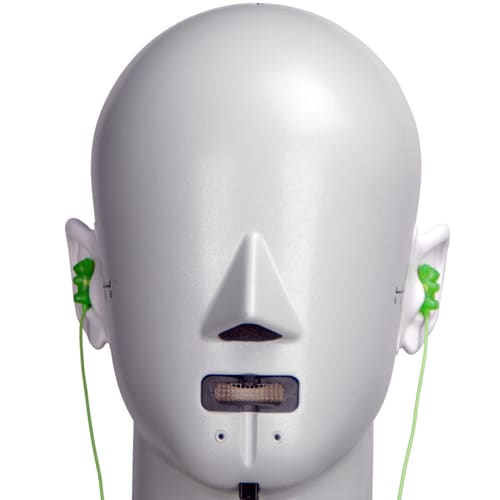
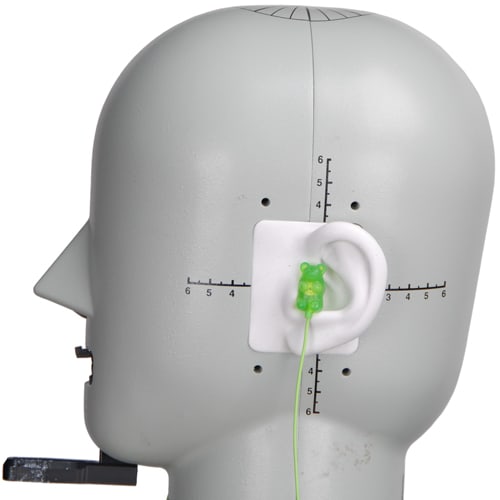
The ear bud is a small, irregular hexagon. From the tip of its nozzle to the back is 0.76', top to bottom is 0.4' at its widest, and 0.25' from side to side. The front of each bud is branded with ER-6i and the back has a large, white L or R to identify the channel. The bud is predominantly clear plastic on top of black. The cord attaches directly to the bud; there isn't a leader or guard.
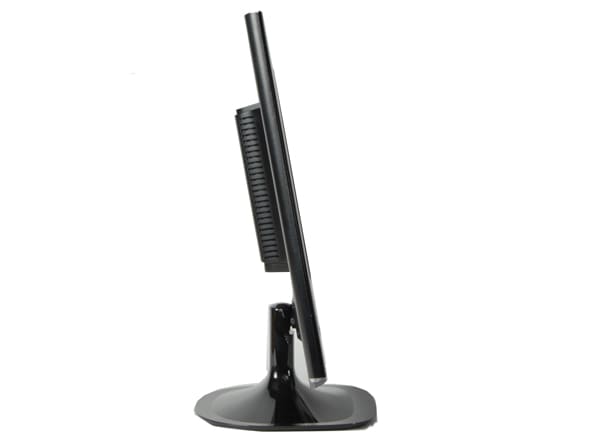

The cord is very thin and black. It has a small, house-shaped split with no slider to adjust the slack under each ear. After the split, the two cables merge, but retain their shapes, creating a valley between them that runs the length of the cord.
The jack meets the cord at a right angle, and the jack housing tapers off into a rubber mesh cage around the base of the cord.
In the Box
{{section_header}}{{section.name}}{{/section_header}}
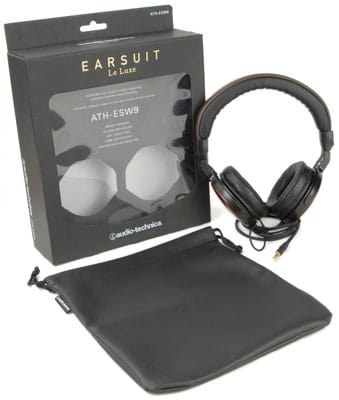
The 6i comes with five pairs of sleeves: short, black foams, taller, peach-colored foams, small- and medium-sized double-flanges, and a pair of triple-flanges. You'll also find two replacement filters -- which fit in the nozzle as a stopper between your ear and the sound element -- as well as a filter-replacement tool. A shirt clip comes pre-attached to the cord. The final bonus is a soft, zipper-up pouch that everything fits into. It has a mesh velcro pocket built in so you can keep your sleeves from falling out.
Durability
{{section_header}}{{section.name}}{{/section_header}}
The 6i's don't seem like the most durable in-ear headphones out there. For one, the cable is very thin, which comes with the added risk of ripping or shearing. The base of the neck split seems be relatively sturdy, at least in relation to the gauge of the cable; it seems like the individual strands would've pulled out before the split tore. The jack's mesh cord-guard is not robust at all, and offers minimal protection at best. Further, the ear buds don't provide any sort of housing for the cable. We definitely feel like we could tear off the ear bud without any great effort.
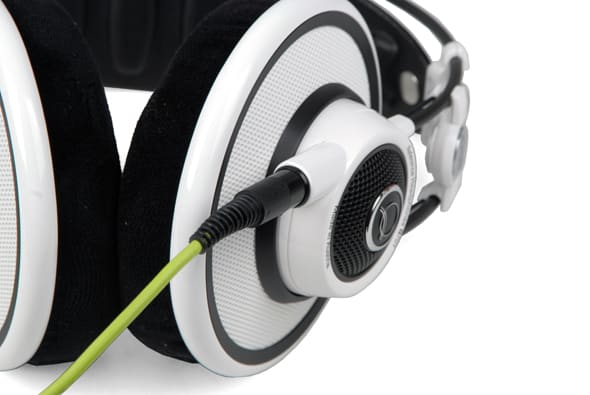
The buds themselves seem to be made of thin plastic, as pushing in on their sides makes creaking sounds. Fortunately, the nozzle is relatively thick, so it shouldn't break off easily.
The sleeves fit well over the nozzle; they won't fall off easily, but still slide on without having to force them too much. The overall quality of the sleeves seems to be good durability-wise. The two sets of foam sleeves are obviously more of a durability risk than the plastic ones, since they will break down faster and are harder to clean.
Aesthetics
{{section_header}}{{section.name}}{{/section_header}}
There really isn't much to the 6i's to judge them on aesthetic appeal. Most of the device is simply hidden by your ear, so at most people will see a small bit of black plastic with a plain black cord coming out. These headphones should be good for those who dislike large headsets, or who are sick of seeing white headphone cables everywhere.
Summary
{{section_header}}{{section.name}}{{/section_header}}

The 6isolator headphones are an in-ear offering from Etymotic Research. As in-ear headphones, they're tiny, portable, and have decent sound quality. The size of these headphones is really minute: the buds are barely visible outside your ears. The lack of a cable guard between the buds and the cable just makes them even more inconspicuous. The cable is of questionable quality, however, as it's thin and tends to hold wrinkles easily.
Frequency Response
{{section_header}}{{section.name}}{{/section_header}}
One of the fundamental aspects of performance in headphones is frequency response; how accurately do the headphones reproduce the many frequencies in music? Our testing system analyzes this by sending a frequency sweep to the headphones that goes from the very low (about 80Hz, which sounds like an earthquake) to the very high (20kHz, which is higher than most people can hear) and analyzing the sound the headphone outputs. How well the headphones reproduce these frequencies is shown on the graph below: low frequencies are on the left, high on the right. The green line is for the left channel, the red is for the right.
The dotted lines indicate the limits we look for; if anything were to veer too widely above or below these limits, that would indicate the headphones are either over emphasizing or suppressing those frequencies. The ER6i does well in this test; the curve is smooth and doesn't go far outside our limits. The curve is also smooth at the left side, indicating there is plenty of bass response for those big drum sounds. As with all in-ear headphones, the bass response is very much dependent on the seal of the headphones against your ear; if they aren't correctly installed to create a good seal, the bass sounds thin and flat. If properly installed, however, the ER6i headphones produce good sound.
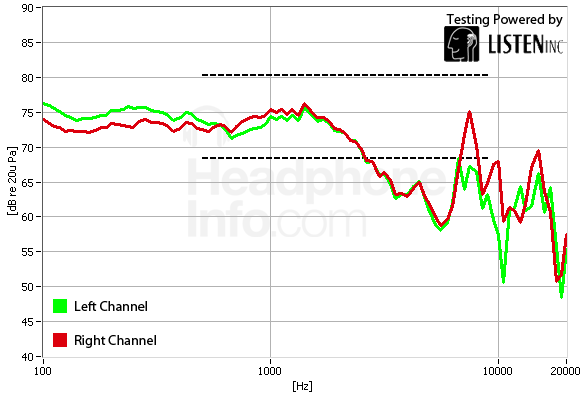
Distortion
{{section_header}}{{section.name}}{{/section_header}}
The evil gremlin waiting to wreck your pleasant audio experience is distortion, where the headphones clip or otherwise mangle the sound because they can't accurately reproduce it. We did see some minor distortion on the ER6i headphones.
Our system examines the distortion that headphones introduce by playing back a frequency sweep of sounds across the frequency range at a listening level of around 90 dB (which is fairly loud, but highlights the distortion) and examining the results for any differences from the original waveform. The graph below shows what's called the Total Harmonic Distortion (THD), which is the amount of distortion (as a percentage) of the basic frequency, as well as the important harmonics that provide the texture and subtleties of musical instruments. If these are distorted, the instrument won't sound right; think of a clear guitar note and a distorted one from a heavy metal solo. The graph starts with low, bassy frequencies at the left and goes up to high frequencies at the right. Again, the green line is the left channel and the red line is the right.
We did notice a certain amount of distortion on the ER6is; the graph is consistently hovering at around 0.5 percent. There are a couple of peaks here and there, but none of these peaks are particularly large, rising only to about 1 percent. Overall, the E6is did fairly well in this test. There's some distortion, but most won't notice it.
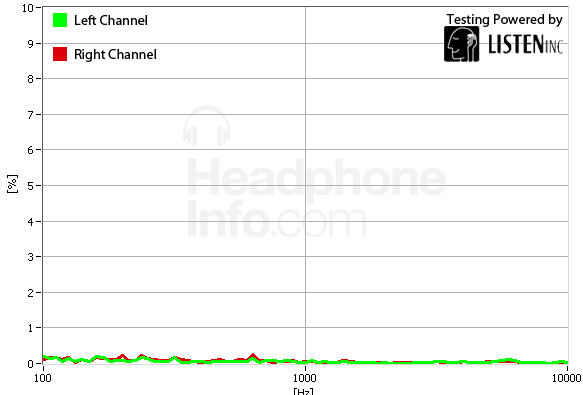
Tracking
{{section_header}}{{section.name}}{{/section_header}}
Headphones have one channel for each ear, so it is vital for good performance that both sides are identical. That's what we test in the tracking test, and the ER6i headphones did well here; we found a maximum difference between the two channels of just more than one percent, which most people won't even notice.
Our test system produces the graph below, which shows the tracking across the frequency range of 80 to 2kHz. If the line is at 0 percent, that indicates the sound at that frequency is identical in both channels. If it goes above that line, the left channel is stronger, and if it goes below, the right channel is is putting out more.
The ER6is really didn't have any problems with tracking. As you can see, the curve stays close to 0 percent error for most of the audio spectrum, with only a minor blip in the high end.
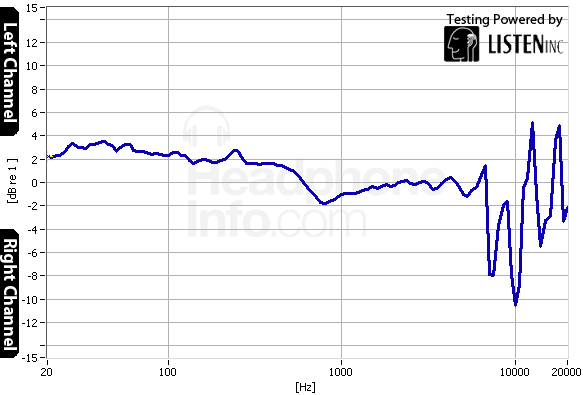
Maximum Usable Volume
{{section_header}}{{section.name}}{{/section_header}}
Most people listen to headphones at reasonable volume levels, but some people like it loud. So, we also test how loud headphones can go without the sound turning into a distorted mess. We test this by how high we can take the volume until the distortion in the sound reaches 3 percent, where it becomes audible and annoying. The ER6Is keeps the distortion below this level until we push the volume to a maximum level of 120dB, which is loud enough to cause hearing damage. And remember; our testing system has replaceable ears; yours are not. If you crank the volume up that high, you're likely to permanently damage them.
Isolation
{{section_header}}{{section.name}}{{/section_header}}
The Er6i headphones are effectively ear plugs with built-in speakers, so it's no surprise they do an excellent job blocking sound from the outside world. We measured the average sound reduction across the board at an impressive 30db, which is a lot.
The graph below shows the same frequency range of 80 to 10,000Hz, with the green line indicating how much sound is blocked at that frequency. Higher is better.
This shows the headphones are most effective at blocking high frequency sounds, such as screaming children or dental drills. They are less effective at blocking low frequencies, though, as these can still get through the earplug effect of the headphones.
It's also worth comparing these against the performance of headphones that include an active noise canceling circuit, like the Bose QuietComfort 2 and 3. The ER6is are more effective overall, but the active noise cancellation of the QuietComfort headphones does a slightly better job at low frequencies, so they block more noise similar to the engine inside an airplane or the dull rumbling of your stomach before lunch. If you're looking for a set of headphones to specifically block noise, the choice comes down to how you feel about sticking things in your ears; if you don't like the idea, the Bose QuietComforts are a better choice, as they fit on (with the QuietComfort 3) or over (the QuietComfort 2) the ear.
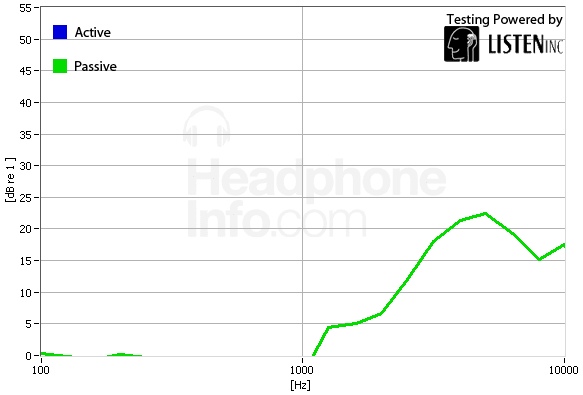
Leakage
{{section_header}}{{section.name}}{{/section_header}}
As well as blocking outside sounds, the Etymotic ER6i headphones do a good job keeping your music private; we found in our tests that only a very very small amount of sound escapes from the headphones when they are correctly fitted. So your choice of music remains a private one, even on a crowded bus or train on the way into work.
Short-Term Use
{{section_header}}{{section.name}}{{/section_header}}
We performed this entirely subjective comfort test with the medium-sized, double-flanged sleeves, since we feel they are the most comfortable. The foam sleeves tend to expand a bit too far, putting pressure on the walls of our ear canal; the smaller set of double-flanges simply didn't provide a good fit; the 3-tiered flanges extend a bit too far into the canal to be comfortable.
The double-flanged sleeves are the most comfortable. After a while the sensation there was something in our ears dissipated almost entirely. Our short-term use test only lasts an hour, and we felt no discomfort from using these for that period of time.
In terms of cord length, we thought it was appropriate for use with most computer setups or portable music players. It would be especially good for exercising, since the buds stayed in our ears despite moderate tugging. The cord might not be long enough for use with home theater setups, however. As these headphones aren't intended for such use, however, we doubt this issue will put off many potential buyers. We never felt the cord was overly long.
Extended Use
{{section_header}}{{section.name}}{{/section_header}}
The 6isolators hold up surprisingly well during extended listening sessions. Typically in-ear headphones exert pressure on the inside of your ear canal, which gets increasingly irritating over time. Even after six hours, however, we didn't notice much difference. These are good in-ear headphones for a long listening session.
Cable Connectivity
{{section_header}}{{section.name}}{{/section_header}}
The 6i's cable is five feet long in total, with the split located about 16 inches away from the buds. As mentioned in the durability section, the cable on the 6i system isn't particularly robust. It is a relatively thin gauge, measuring a mere 0.05 inches in diameter, and its casing doesn't feel like it would stand up to much punishment. The cable holds a bend, which is exacerbated by the lack of a cable management tool. This means users will have to fold up the cable themselves before putting it in a pocket; chances are the cord will look wrinkled when the user pulls them out.
The 6i's plug doesn't fit into the iPhone; if your device's jack is recessed at all, the headphones won't click into place fully correctly, causing them to not work or fall out easily.
Customizability
{{section_header}}{{section.name}}{{/section_header}}
The 6i system comes with three different types of sleeves: double-flanged, triple-flanged, and foam. Both the double-flanged and foam sleeves come with two different sizes. The double-flanged has a small and medium size, while the foam sleeves have a medium and large size.
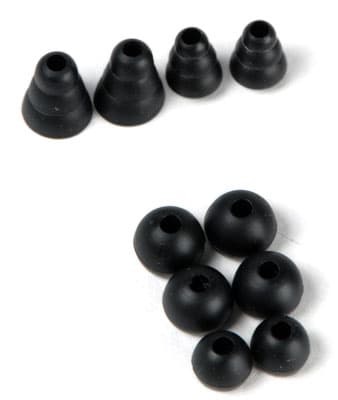

The cord cannot be customized; while the Shure SE210s come with a cord extender, there is nothing similar on the E6i. There is no expansion jack near the neck split, and the neck split itself isn't movable. There is a shirt clip included to help manage the cord while in use.
Portability
{{section_header}}{{section.name}}{{/section_header}}
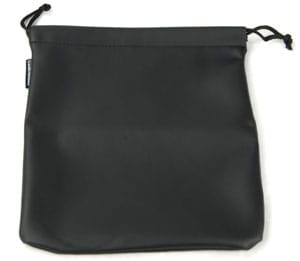
The pouch doesn't have any inner pockets or cord-managing features, so it's not particularly helpful.
As in-ear headphones, the 6i headphones are very portable. The included case is a nice addition, but only helps slightly with portability. We like its mesh pocket, since it gives a separate, sealed-off storage location for the sleeves. The case is also very small, which is a big help. The only real feature we would've liked was some kind of cord management. The cord is a bit unruly as it is, and bunching it up in a pouch will only make matters worse.
Maintenance
{{section_header}}{{section.name}}{{/section_header}}
The 6i system comes with two replacement filters that fit inside the nozzle. Also included is a pointy metal stick you can use to extract a filter with. Since the removal process requires you to impale the filter, removing one destroy it. The impaling device isn't particularly good at cleaning the edges of the sleeves, but it is good for scrubbing out the interiors. The fact that you can remove the sleeves definitely aids in cleaning them. A new pack of six filters costs $15.
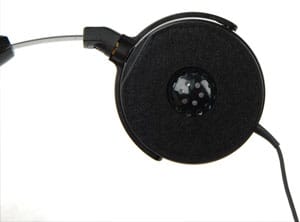
Once you take off the pad, there isn't much more you can do.
Though the kit has five sets of removable sleeves, it contains no duplicates. The sleeves break down over time (your ear is not a nice place in some ways), but the replacement sleeves are cheap; $14 for five.
Other Features
{{section_header}}{{section.name}}{{/section_header}}
Battery
Because the 6i headphones don't rely on battery, they get an automatic five points. Besides this bonus for battery independence, the 6i headphones have no additional features.
Value
{{section_header}}{{section.name}}{{/section_header}}
At $140, the Etymotic Research 6isolator headphones are about the same price as the Shure SE210s. They have pretty good sound quality for in-ear headphones, are comfortable, and are very portable. Like all in-ear headphones that extend into the canal, the 6isolator headphones offer good sound isolation.
Of course, compared to most on-ear or over-ear headphones, these don't offer very good sound quality. If you are looking for a nice set of portable headphones with a nice case and a good collection of sleeves, the 6isolators are priced to please.
Conclusion
{{section_header}}{{section.name}}{{/section_header}}
The Etymotic Research 6isolator headphones are definitely a pair of in-ears to consider. They come with good sleeve options, a great case to help them be even more portable, and cleaning gear to help maintain audio quality. Audio quality was decent; there will be some distortion, and the tracking was a bit erratic, but that's what you get with sound elements this small.
Again, their main low point is their cable, which will hold a serpentine series of kinks for a long time if you don't actively try to straighten it out, and which could snap fairly easily. If you don't mind a crinkled cord, however, the 6isolators are a great pair of portable headphones.
Meet the tester
Mark Brezinski works on the Home Team, reviewing refrigerators, minifridges, dishwashers, washing machines, dryers, air conditioners, air purifiers, and fans.
Checking our work.
Our team is here to help you buy the best stuff and love what you own. Our writers, editors, and experts obsess over the products we cover to make sure you're confident and satisfied. Have a different opinion about something we recommend? Email us and we'll compare notes.
Shoot us an email